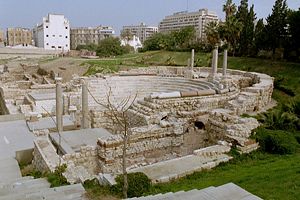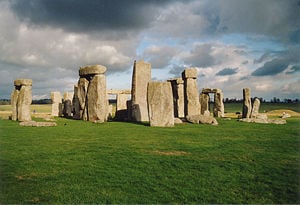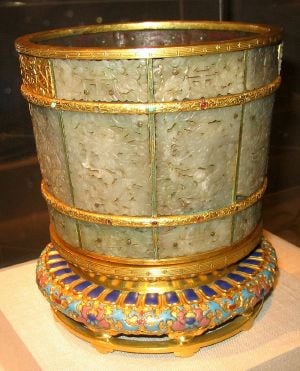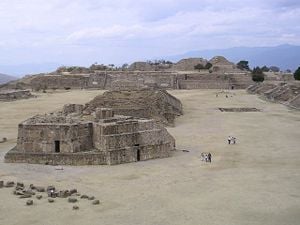Archaeology
Archaeology, archeology, or archæology (from the Greek words αρχαίος = ancient and λόγος = word/speech/discourse) is the study of human cultures through the recovery, documentation and analysis of material remains and environmental data, including architecture, artifacts, biofacts, human remains, and landscapes.
The goals of archaeology are to document and explain the origins and development of human culture, understand culture history, chronicle cultural evolution, and study human behavior and ecology, for both prehistoric and historic societies. It is considered to be one of the four sub-fields of anthropology.
Usage
As with words such as encyclopedia and gynaecology, archaeology traditionally has an ae combination; however, unlike many other words, the ae is still widely retained. Contrary to popular belief in other parts of the world, the spelling archeology is not predominant in United States dictionaries, though it is the spelling used by the United States government organizations involved in the field. The traditional spelling, archaeology, continues to be the most common form in everyday writing throughout the world, including the U.S.
Origins and definition
In the Old World, archaeology has tended to focus on the study of physical remains, the methods used in recovering them and the theoretical and philosophical underpinnings in achieving the subject's goals. The discipline's roots in antiquarianism and the study of Latin and Ancient Greek provided it with a natural affinity with the field of history. In the New World, archaeology is more commonly devoted to the study of human societies and is treated as one of the four subfields of Anthropology. The other subfields of anthropology supplement the findings of archaeology in a holistic manner. These subfields are cultural anthropology, which studies behavioural, symbolic, and material dimensions of culture; linguistics, which studies language, including the origins of language and language groups; and physical anthropology, which includes the study of human evolution and physical and genetic characteristics. Other disciplines also supplement archaeology, such as paleontology, paleozoology, paleoethnobotany, paleobotany, geography, geology, art history, and classics.
Archaeology has been described as a craft that enlists the sciences to illuminate the humanities. Writing in 1948, the American archaeologist Walter Taylor asserted that "Archaeology is neither history nor anthropology. As an autonomous discipline, it consists of a method and a set of specialised techniques for the gathering, or 'production' of cultural information". [citation needed]
Archaeology is an approach to understanding human culture through its material remains regardless of chronology. In England, archaeologists have uncovered the long-lost layouts of medieval villages abandoned after the crises of the 14th century and the equally lost layouts of 17th century parterre gardens swept away by a change in fashion. In downtown New York City archaeologists have exhumed the 18th century remains of the Black burial ground. Traditional Archaeology is viewed as the study of pre-historical human cultures; that is cultures that existed before the development of writing for that culture. Historical archaeology is the study of cultures with some form of writing.
In the study of relatively recent cultures, which have been observed and studied by Western scholars, archaeology is closely allied with ethnography. This is the case in large parts of North America, Oceania, Siberia, and other places where the study of archaeology mingles with the living traditions of the cultures being studied. Kennewick Man is an example of archaeology interacting with modern culture. In the study of cultures that were literate or had literate neighbours, history and archaeology supplement one another for broader understanding of the complete cultural context, as at Hadrian's Wall.
Importance and applicability
Most of human history is not described by any written records. Writing as it is known and understood today did not exist anywhere in the world until about 5000 years ago, and only spread among a relatively small number of technologically advanced civilisations. In contrast Homo sapiens have existed for at least 200,000 years, and other species of Homo for millions of years (see Human evolution). These civilisations are, not coincidentally, the best-known; they have been open to the inquiry of historians for centuries, while the study of pre-historic cultures has arisen only recently. Even within a civilisation that is literate at some levels, many important human practices are not officially recorded. Any knowledge of the formative early years of human civilisation - the development of agriculture, cult practices of folk religion, the rise of the first cities - must come from archaeology.
Even where written records do exist, they are invariably incomplete or biased to some extent. In many societies, literacy was restricted to the elite classes, such as the clergy or the bureaucracy of court or temple. The literacy even of an aristocracy has sometimes been restricted to deeds and contracts. The interests and world-view of elites are often quite different from the lives and interests of the rest of the populace. Writings that were produced by people more representative of the general population were unlikely to find their way into libraries and be preserved there for posterity. Thus, written records tend to reflect the biases of the literate classes, and cannot be trusted as a sole source. The material record is nearer to a fair representation of society, though it is subject to its own inaccuracies, such as sampling bias and differential preservation.
In addition to their scientific importance, archaeological remains sometimes have political significance to descendants of the people who produced them, monetary value to collectors, or simply strong aesthetic appeal. Many people identify archaeology with the recovery of such aesthetic, religious, political, or economic treasures rather than with the reconstruction of past societies.
This view is often espoused in works of popular fiction, such as Raiders of the Lost Ark, The Mummy, and King Solomon's Mines. When such unrealistic subjects are treated more seriously, accusations of pseudoscience are invariably levelled at their proponents (see Pseudoarchaeology, below). However, these endeavours, real and fictional, are not representative of the modern state of archaeology.
Goals
There is still a tremendous emphasis in the practice of archaeology on field techniques and methodologies. These include the tasks of surveying areas in order to find new sites, digging [sites in order to unearth the cultural remains therein, and classification and preservation techniques in order to analyse and keep these remains. Every phase of this process can be a source of information.
The goals of archaeology are not always the same. There are at least three broad, distinct theories of exactly what archaeological research should do. (These are beyond the scope of the present discussion, and are discussed at length below.) Nevertheless, there is much common ground.
History of archaeology
The history of archaeology has been one of increasing professionalisation, and the use of an increasing range of techniques, to obtain as much data on the site being examined as possible.
Excavations of ancient monuments and the collection of antiquities have been taking place for thousands of years, but these were mostly for the extraction of valuable or aesthetically pleasing artefacts.
It was only in the 19th century that the systematic study of the past through its physical remains began to be carried out. A notable early development was the founding in Rome in 1829, by Eduard Gerhard and others, of the Institute for Archaeological Correspondence (Instituto di corrispondenza archeologica or Institut für archäologisches Korrespondenz). Archaeological methods were developed by both interested amateurs and professionals, including Augustus Pitt Rivers and William Flinders Petrie.
This process was continued in the 20th century by such people as Mortimer Wheeler, whose highly disciplined approach to excavation greatly improved the quality of evidence that could be obtained.
During the 20th century, the development of urban archaeology and then rescue archaeology have been important factors, as has the development of archaeological science, which has greatly increased the amount of data that it is possible to obtain.
Academic sub-disciplines
As with most academic disciplines, there are a number of archaeological sub-disciplines typically characterised by a focus on a specific method or type of material, geographical or chronological focus, or other thematic concern. In addition, certain civilisations have attracted so much attention that their study has been specifically named. These sub-disciplines include Assyriology (Mesopotamia), Phoeniciology (Phoenicia), Classical archaeology (Greece and Rome), and Egyptology (Egypt).
The other main division of archaeology is into historical archaeology, which examines civilisations that left behind written records and prehistoric archaeology, which concerns itself with societies that did not have writing systems. However, the term is generally valid only in Europe and Asia where literate societies emerged without colonial influence. In areas where literacy arrived relatively late, it is more convenient to use other terms to divide up the archaeological record. In areas of semi-literacy the term protohistoric archaeology can be adopted to cover the study of societies with very limited written records. One example of a protohistoric site is Fort Ross on the northern California coast, which included settlements of literate Russians and non-literate American Indians and Alaska natives.
Ethnoarchaeology is the study of modern societies resembling extinct ones of archaeological interest, for archaeological purposes. It is often difficult to infer solid conclusions about the structure and values of ancient societies from their material remains, not only because objects are mute and say little about those who crafted and used them, but also because not all objects survive to be uncovered by scholars of a later age. Ethnoarchaeology seeks to determine, for instance, what kinds of objects used in a living settlement are deposited in middens or other places where they may be preserved, and how likely an object is to be discarded near to the place where it was used.
Taphonomy is the study of how objects decay and degrade over time. This information is critical to the interpretation of artefacts and other objects, so that the work of ancient people can be differentiated from the later work of living creatures and elemental forces.
A selective list of sub-disciplines distinguished by time period or region of study is given below.
- African archaeology, Archaeology of the Americas, Australian archaeology, European archaeology: focuses on archaeologic study concerning the location of the findings.
- Industrial archaeology focuses on the preservation of material relics of the Industrial Revolution.
- Near Eastern archaeology (sometimes known as Middle Eastern archaeology). See also Biblical archaeology, which applies the results of Near Eastern archaeology to the study of the Bible.
- Medieval archaeology is the study of post-Roman European archaeology until the sixteenth century.
- Post-medieval archaeology is the study of material culture in Europe from the 16th century onwards.
- Modern archaeology is the study of modern society using archaeological methods, e.g. the Tucson Garbage Project.
The following is a list of other sub-disciplines. Some of these are not areas of study in their own right, and are only methods to be used in larger projects.
- Aerial archaeology studying sites from air photos, especially by identifying cropmarks
- Archaeoastronomy is the study of the relationship between the configuration of ancient monuments and astronomy.
- Archaeological science or Archaeometry is the application of scientific techniques or methodologies to archaeology such as radiocarbon dating, statistics and remote sensing.
- Archaeozoology is the study of animal remains in human settlements.
- Archaeobotany or paleoethnobotany is the study of human-plant interaction in the archaeological record.
- Computational archaeology is the application of computers, particularly GIS, to archaeology
- Experimental archaeology involves attempting to re-enact past processes to test theories about ancient manufacturing, engineering and the effects of time on sites and objects (for example flint-knapping)
- Environmental archaeology studies the long-term relationship between humans and their environments.
- Forensic archaeology is the application of archaeological techniques to criminal investigations. It has become particularly prominent in the investigation of mass-killings associated with war crimes.
- Landscape archaeology involves identifying and studying sites as components in a wider geographical area.
- Maritime archaeology is the study of submerged archaeological sites, including shipwrecks as well as settlements that have been engulfed by bodies of water.
- Museum studies is the display and interpretation of past remains for the public.
- Paleopathology is the study of ancient disease amongst animals and humans.
There are also a wide variety of techniques used for post-excavation analysis.
Cultural resources management (CRM) (also called heritage management in Britain) is a branch of archaeology that accounts for most research done in the United States and much of that in western Europe as well. In the United States, CRM archaeology has been a growing concern since the passage of the National Historic Preservation Act of 1966 and most of the archaeology done in that country today proceeds from either direct or related requirements of that measure. In the United States, the vast majority of taxpayers, scholars, and politicians believe that CRM has helped to preserve much of that nation's history and prehistory that would have otherwise been lost in the expansion of cities, dams, and highways. Along with other statutes, this mandates that no construction project on public land or involving public funds may damage an unstudied archaeological site.
The application of CRM in the United Kingdom is not limited to government-funded projects. Since 1990 PPG 16 has required planners to consider archaeology as a material consideration in determining applications for new development. As a result, numerous archaeological organisations undertake mitigation work in advance of (or during) construction work in archaeologically sensitive areas, at the developer's expense.
Among the goals of CRM are the identification, preservation, and maintenance of cultural sites on public and private lands, and the removal of culturally valuable materials from areas where they would otherwise be destroyed by human activity, such as proposed construction. This study involves at least a cursory examination to determine whether or not any significant archaeological sites are present in the area affected by the proposed construction. If these do exist, time and money must be allotted for their excavation. If initial survey and/or test excavation indicates the presence of an extraordinarily valuable site, the construction may be prohibited entirely. CRM is a thriving entity, especially in the United States and Europe where archaeologists from private companies and all levels of government engage in the practice of their discipline.
Cultural resources management has, however, been criticized. CRM is conducted by private companies that bid for projects by submitting proposals outlining the work to be done and an expected budget. It is not unheard-of for the agency responsible for the construction to simply choose the proposal that asks for the least funding. CRM archaeologists face considerable time pressure, often being forced to complete their work in a fraction of the time that might be allotted for a purely scholarly endeavour.
Field methods
Survey
A modern archaeological project often begins with a survey. Regional survey is the attempt to systematically locate previously unknown sites in a region. Site survey is the attempt to systematically locate features of interest, such as houses and middens, within a site. Each of these two goals may be accomplished with largely the same methods.
Survey was not widely practiced in the early days of archaeology. Cultural historians and prior researchers were usually content with discovering the locations of monumental sites from the local populace, and excavating only the plainly visible features there. Gordon Willey pioneered the technique of regional settlement pattern survey in 1949 in the Viru Valley of coastal Peru, and survey of all levels became prominent with the rise of processual archaeology some years later.
Survey work has many benefits if performed as a preliminary exercise to, or even in place of, excavation. It requires relatively little time and expense, because it does not require processing large volumes of soil to search out artefacts. (Nevertheless, surveying a large region or site can be expensive, so archaeologists often employ sampling methods.) It avoids ethical issues (of particular concern to descendant peoples) associated with destroying a site through excavation. It is the only way to gather some forms of information, such as settlement patterns and settlement structure. Survey data are commonly assembled into maps, which may show surface features and/or artefact distribution.
The simplest survey technique is surface survey. It involves combing an area, usually on foot but sometimes with the use of mechanised transport, to search for features or artefacts visible on the surface. Surface survey cannot detect sites or features that are completely buried under earth, or overgrown with vegetation. Surface survey may also include mini-excavation techniques such as augers, corers, and shovel test pits.
Aerial survey is conducted using cameras attached to aircraft, balloons, or even kites. A bird's-eye view is useful for quick mapping of large or complex sites. Aerial imaging can also detect many things not visible from the surface. Plants growing above a stone structure, such as a wall, will develop more slowly, while those above other types of features (such as middens) may develop more rapidly. Photographs of ripening grain, which changes colour rapidly at maturation, have revealed buried structures with great precision. Aerial survey also employs infrared, ground-penetrating radar wavelengths, and thermography.
Geophysical survey is the most effective way to see beneath the ground. Magnetometers detect minute deviations in the Earth's magnetic field caused by iron artefacts, kilns, some types of stone structures, and even ditches and middens. Devices that measure the electrical resistivity of the soil are also widely used. Most soils are moist below the surface, which gives them a relatively low resistivity. Features such as hard-packed floors or concentrations of stone have a higher resistivity.
Although some archaeologists consider the use of metal detectors to be tantamount to treasure hunting, others deem them an effective tool in archaeological surveying. Examples of formal archaeological use of metal detectors include musketball distribution analysis on English Civil War battlefields, metal distribution analysis prior to excavation of a nineteenth century ship wreck, and service cable location during evaluation. Metal detectorists have also contributed to the archaeological record where they have made detailed records of their results and refrained from raising artifacts from their archaeological context. In the UK, metal detectorists have been solicited for involvement in the Portable Antiquities Scheme.
Regional survey in maritime archaeology uses side-scan sonar.
Excavation
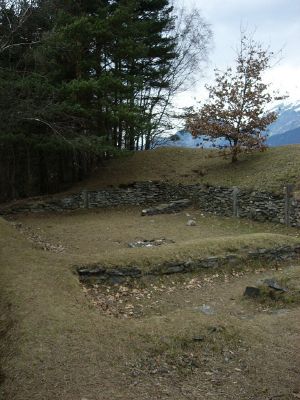
Archaeological excavation existed even when the field was still the domain of amateurs, and it remains the source of the majority of data recovered in most field projects. It can reveal several types of information usually not accessible to survey, such as stratigraphy, three-dimensional structure, and verifiably primary context.
Modern excavation techniques require that the precise locations of objects and features, known as their provenance or provenience, be recorded. This always involves determining their horizontal locations, and sometimes vertical position as well (also see Primary Laws of Archaeology). Similarly, their association, or relationship with nearby objects and features, needs to be recorded for later analysis. This allows the archaeologist to deduce what artefacts and features were likely used together and which may be from different phases of activity. For example, excavation of a site reveals its stratigraphy; if a site was occupied by a succession of distinct cultures, artefacts from more recent cultures will lie above those from more ancient cultures.
Excavation is the most expensive phase of archaeological research. Also, as a destructive process, it carries ethical concerns. As a result, very few sites are excavated in their entirety. Sampling is even more important in excavation than in survey. It is common for large mechanical equipment, such as backhoes (JCBs), to be used in excavation, especially to remove the topsoil (overburden), though this method is increasingly used with great caution. Following this rather dramatic step, the exposed area is usually hand-cleaned with trowels or hoes to ensure that all features are apparent.
The next task is to form a site plan and then use it to help decide the method of excavation. Features dug into the natural subsoil are normally excavated in portions in order to produce a visible archaeological section for recording. Scaled plans and sections of individual features are all drawn on site, black and white and colour photographs of them are taken, and recording sheets are filled in describing the context of each. All this information serves as a permanent record of the now-destroyed archaeology and is used in describing and interpreting the site.
Post-excavation analysis
Once artefacts and structures have been excavated, or collected from surface surveys, it is necessary to properly study them, to gain as much data as possible. This process is known as post-excavation analysis, and is normally the most time-consuming part of the archaeological investigation. It is not uncommon for the final excavation reports on major sites to take years to be published.
At its most basic, the artefacts found are cleaned, catalogued and compared to published collections, in order to classify them typologically and to identify other sites with similar artefact assemblages. However, a much more comprehensive range of analytical techniques are available through archaeological science, meaning that artefacts can be dated and their compositions examined. The bones, plants and pollen collected from a site can all be analysed (using the techniques of zooarchaeology, paleoethnobotany, and palynology), while any texts can usually be deciphered.
These techniques frequently provide information that would not otherwise be known and therefore contribute greatly to the understanding of a site.
Archaeological theory
There is no single theory of archaeology, and even definitions are disputed. Until the mid-20th century and the introduction of technology, there was a general consensus that archaeology was closely related to both history and anthropology. The first major phase in the history of archaeological theory is commonly referred to as cultural, or culture, history, which was developed during the late 19th and early 20th centuries.
In the 1960s, a number of young, primarily American archaeologists, such as Lewis Binford, rebelled against the paradigms of cultural history. They proposed a "New Archaeology", which would be more "scientific" and "anthropological", with hypothesis testing and the scientific method very important parts of what became known as processual archaeology.
In the 1980s, a new movement arose led by the British archaeologists Michael Shanks, Christopher Tilley, Daniel Miller, and Ian Hodder. It questioned processualism's appeals to science and impartiality and emphasised the importance of relativism, becoming known as post-processual archaeology. However, this approach has been criticised by processualists as lacking scientific rigour. The validity of both processualism and post-procuessualism is still under debate.
Archaeological theory now borrows from a wide range of influences, including neo-Darwinian evolutionary thought, phenomenology, postmodernism, agency theory, cognitive science, Functionalism, gender-based and Feminist archaeology, and Systems theory.
Public archaeology
Early archaeology was largely an attempt to uncover spectacular artifacts and features, or to explore vast and mysterious abandoned cities. Such pursuits continue to fascinate the public, portrayed in books (such as King Solomon's Mines) and films (such as The Mummy and Raiders of the Lost Ark).
Much thorough and productive research has indeed been conducted in dramatic locales such as Copán and the Valley of the Kings, but the stuff of modern archaeology is not so reliably sensational. In addition, archaeological adventure stories tend to ignore the painstaking work involved in modern survey, excavation, and data processing techniques. Some archaeologists refer to such portrayals as "pseudoarchaeology".
Nevertheless, archaeology has profited from its portrayal in the mainstream media. Many practitioners point to the childhood excitement of Indiana Jones films and Tomb Raider games as the inspiration for them to enter the field. Archaeologists are also very much reliant on public support, the question of exactly who they are doing their work for is often discussed. Without a strong public interest in the subject, often sparked by significant finds and celebrity archaeologists, it would be a great deal harder for archaeologists to gain the political and financial support they require.
In the UK, popular archaeology programmes such as Time Team and Meet the Ancestors have resulted in a huge upsurge in public interest. Where possible, archaeologists now make more provision for public involvement and outreach in larger projects than they once did. However, the move towards being more professional has meant that volunteer places are now relegated to unskilled labour, and even this is less freely available than before. Developer-funded excavation necessitates a well-trained staff that can work quickly and accurately, observing the necessary health and safety and indemnity insurance issues involved in working on a modern building site with tight deadlines. Certain charities and local government bodies sometimes offer places on research projects either as part of academic work or as a defined community project. There is also a flourishing industry selling places on commercial training excavations and archaeological holiday tours.
Archaeologists prize local knowledge and often liaise with local historical and archaeological societies. Anyone looking to get involved in the field without having to pay to do so should contact a local group.
Pseudoarchaeology
Pseudoarchaeology is an umbrella term for all activities that claim to be archaeological but in fact violate commonly accepted archaeological practices. It includes much fictional archaeological work (discussed above), as well as some actual activity. Many non-fiction authors have ignored the scientific methods of processual archaeology, or the specific critiques of it contained in post-processualism.
An example of this type is the writing of Erich von Däniken. His Chariots of the Gods (1968), together with many subsequent lesser-known works, expounds a theory of ancient contacts between human civilisation on Earth and more technologically advanced extraterrestrial civilisations. This theory, known as palaeocontact theory, is not exclusively Däniken's nor did the idea originate with him. Works of this nature are usually marked by the renunciation of well-established theories on the basis of limited evidence, and the interpretation of evidence with a preconceived theory in mind.
Looting
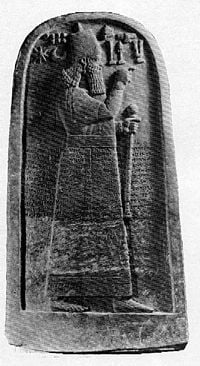
Looting of archaeological sites by people in search of hoards of buried treasure is an ancient problem. For instance, many of the tombs of the Egyptian pharaohs were looted in antiquity. The advent of archaeology has made ancient sites objects of great scientific and public interest, but it has also attracted unwelcome attention to the works of past peoples. A brisk commercial demand for artefacts encourages looting and the illicit antiquities trade, which smuggles items abroad to private collectors. Looters damage the integrity of a historic site, deny archaeologists valuable information that would be learnt from excavation, and are often deemed to be robbing local people of their heritage.
The popular consciousness often associates looting with poor Third World countries. Many are former homes to many well-known ancient civilizations but lack the financial resources or political will to protect even the most significant sites. Certainly, the high prices that intact objects can command relative to a poor farmer's income make looting a tempting financial proposition for some local people. However, looting has taken its toll in places as rich and populous as the United States and Western Europe as well. Abandoned towns of the ancient Sinagua people of Arizona, clearly visible in the desert landscape, have been destroyed in large numbers by treasure hunters. Sites in more densely populated areas farther east have also been looted. Where looting is proscribed by law it takes place under cover of night, with the metal detector a common instrument used to identify profitable places to dig.
Public outreach
Motivated by a desire to halt looting, curb pseudoarchaeology, and to secure greater public funding and appreciation for their work, archaeologists are mounting public-outreach campaigns. They seek to stop looting by informing prospective artefact collectors of the provenance of these goods, and by alerting people who live near archaeological sites of the threat of looting and the danger that it poses to science and their own heritage. Common methods of public outreach include press releases and the encouragement of school field trips to sites under excavation.
The final audience for archaeologists' work is the public and it is increasingly realised that their work is ultimately being done to benefit and inform them. The putative social benefits of local heritage awareness are also being promoted with initiatives to increase civic and individual pride through projects such as community excavation projects and better interpretation and presentation of existing sites.
Descendant peoples
In the United States, examples such as the case of Kennewick Man have illustrated the tensions between Native Americans and archaeologists which can be summarised as a conflict between a need to remain respectful towards burials sacred sites and the academic benefit from studying them. For years, American archaeologists dug on Indian burial grounds and other places considered sacred, removing artefacts and human remains to storage facilities for further study. In some cases human remains were not even thoroughly studied but instead archived rather than reburied. Furthermore, Western archaeologists' views of the past often differ from those of tribal peoples. The West views time as linear; for many natives, it is cyclic. From a Western perspective, the past is long-gone; from a native perspective, disturbing the past can have dire consequences in the present. To an archaeologist, the past is long-gone and must be reconstructed through its material remains; to indigenous peoples, it is often still alive.
As a consequence of this, American Indians attempted to prevent archaeological excavation of sites inhabited by their ancestors, while American archaeologists believed that the advancement of scientific knowledge was a valid reason to continue their studies. This contradictory situation was addressed by the Native American Graves Protection and Repatriation Act (NAGPRA, 1990), which sought to reach a compromise by limiting the right of research institutions to possess human remains. Due in part to the spirit of postprocessualism, some archaeologists have begun to actively enlist the assistance of indigenous peoples likely to be descended from those under study.
Archaeologists have also been obliged to re-examine what constitutes an archaeological site in view of what native peoples believe to constitute sacred space. To many native peoples, natural features such as lakes, mountains or even individual trees have cultural significance. Australian archaeologists especially have explored this issue and attempted to survey these sites in order to give them some protection from being developed. Such work requires close links and trust between archaeologists and the people they are trying to help and at the same time study.
While this cooperation presents a new set of challenges and hurdles to fieldwork, it has benefits for all parties involved. Tribal elders cooperating with archaeologists can prevent the excavation of areas of sites that they consider sacred, while the archaeologists gain the elders' aid in interpreting their [[Small finds|finds[[. There have also been active efforts to recruit aboriginal peoples directly into the archaeological profession.
Repatriation
A new trend in the heated controversy between First Nations groups and scientists is the repatriation of native artifacts to the original descendants. An example of this occurred June 21, 2005, when a community members and elders from a number of the 10 Algonquian nations in the Ottawa area convened on the Kitigan Zibi reservation in Kanawagi, Quebec, to inter ancestral human remains and burial goods — some dating back 6,000 years.
The ceremony marked the end of a journey spanning thousands of years and many miles. The remains and artifacts, including beads, tools and weapons, were originally excavated from various sites in the Ottawa Valley, including Morrison and the Allumette Islands. They had been part of the Canadian Museum of Civilization’s research collection for decades, some since the late 1800s. Elders from various Algonquin communities conferred on an appropriate reburial, eventually deciding on traditional redcedar and birchbark boxes lined with redcedar chips, muskrat and beaver pelts.
Now, an inconspicuous rock mound marks the reburial site where close to 90 boxes of various sizes are buried. Although negotiations were at times tense between the Kitigan Zibi community and museum, they were able to reach agreement [1]
Footnotes
External links
- Archeologia belga The Alphabetical of Archaeology. French Archaeology.
- Archaeology News Current News and Information pertaining to all areas of archaeology, plus free news feeds for webmasters.
- North Pacific Prehistory is an academic journal specialising in Northeast Asian and North American archaeology.
- Excavation Sites Archaeological work and volunteer pages.
- Archaeology in Popular Culture
- Anthropology Resources on the Internet - Anthropology Resources on the Internet : a web directory, part of the WWW Virtual Library, with over 4000 links grouped in specialised topics.
- Archaeology magazine published by the Archaeological Institute of America
- Archaeology Directory - Directory of archaeological topics on the web.
- The 2003- Iraq War & Archaeology Information about looting in Iraq.
- Philosophy and the New Archaeology, an essay at the Galilean Library on the philosophical underpinnning of archaeology and the debate over the New Archaeology.
- Southern African Humanities - Vehicle for human science and heritage research of an archaeological, anthropological and historical nature.
- WWW VL African Archaeology - The african archaeology portal, part of the WWW Virtual Library : all the web sites relating to african archaeology are listed here.
Further reading
- Ashmore, W. and Sharer, R. J., Discovering Our Past: A Brief Introduction to Archaeology Mountain View: Mayfield Publishing Company. ISBN 076741196X. This has also been used as a source.
- Maniscalco, Fabio (ed.), Web Journal on Cultural Patrimony
- Neumann, Thomas W. and Robert M. Sanford, Practicing Archaeology: A Training Manual for Cultural Resources Archaeology Rowman and Littlefield Pub Inc, August, 2001, hardcover, 450 pages, ISBN 0759100942
- Renfrew, Colin & Bahn, Paul G., Archaeology: Theories, Methods and Practice, Thames and Hudson, 4th edition, 2004. ISBN 0500284415
- Sanford, Robert M. and Thomas W. Neumann, Cultural Resources Archaeology: An Introduction, Rowman and Littlefield Pub Inc, December, 2001, trade paperback, 256 pages, ISBN 0759100950
- Trigger, Bruce. 1990. "A History of Archaeological Thought". Cambridge: Cambridge University Press. ISBN 0521338182
Credits
New World Encyclopedia writers and editors rewrote and completed the Wikipedia article in accordance with New World Encyclopedia standards. This article abides by terms of the Creative Commons CC-by-sa 3.0 License (CC-by-sa), which may be used and disseminated with proper attribution. Credit is due under the terms of this license that can reference both the New World Encyclopedia contributors and the selfless volunteer contributors of the Wikimedia Foundation. To cite this article click here for a list of acceptable citing formats.The history of earlier contributions by wikipedians is accessible to researchers here:
The history of this article since it was imported to New World Encyclopedia:
Note: Some restrictions may apply to use of individual images which are separately licensed.
